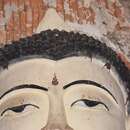fi
nimet breadcrumb-navigoinnissa


Black bearded tomb bats are agile creatures. They cling to vertical surfaces, as well as effortlessly crawling up and down porous surfaces like rock walls and cave crevices.
Information on the communication of these animals is not available. However, tactile communication is obviously important between mothers and their offspring. Some vocal and chemical communication probably occur and help mothers to identify their own offspring in the roost.
Communication Channels: tactile ; acoustic
Perception Channels: visual ; tactile ; acoustic ; chemical
Though not endangered, black-bearded tomb bats areprotected by the Zoological Park Organization of Thailand.
US Migratory Bird Act: no special status
US Federal List: no special status
IUCN Red List of Threatened Species: least concern
Black-bearded tomb bats are not known to have any negative impacts on humans.
These bats may have some economic importance to humans by helping to polinate crops and helping to control insect pests.
Positive Impacts: pollinates crops; controls pest population
Black-bearded tomb bats help control insect populations, and those that feed on fruit may pollinate plants or disperse seeds.
Ecosystem Impact: disperses seeds; pollinates
Taphozous melanopogon feeds primarily on flying insects, although it also sometimes feeds on small fruits. It hunts by echolocation, emitting a "click" or "tic" that can be faintly audible to humans.
Animal Foods: insects
Plant Foods: fruit
Primary Diet: carnivore (Insectivore )
Black bearded tomb bats live in Central India, Indochina, Thailand, Borneo, Burma, and the Philippines. Their range includes Indonesia, Bantam, and West Java, and they are occasionally found in the Malay Peninsula, Sumatra, Borneo, and Lombok.
Biogeographic Regions: oriental (Native )
Black-bearded tomb bats are found in habitats including rainforests, woodlands, tombs, deserted buildings, rock formations, caverns, cliffs, and arid country plains. They prefer densely sheltered areas. They roost in groups ranging from 200 to 4000 individuals.
Habitat Regions: temperate ; tropical ; terrestrial
Terrestrial Biomes: desert or dune ; forest ; rainforest ; scrub forest
Other Habitat Features: urban ; suburban
Little is known about the longevity of these animals, but approximate ages for individuals vary from 5 to 20 years. Infant mortality within this species is particularly high.
Range lifespan
Status: wild: 5 to 20 years.
The coat of black-bearded tomb bats is quite variable dependent on its particular environment. It ranges from grayish to multi-brown or red variations. Hairs are typically white tipped, turning increasingly more red or brown towards the base. Fur is present on the tail (uropatagium) membrane. No throat sac is present, but a series of pores that open into the throat region is present where the sac would be located. Males have a black beard, which is believed to be seasonal. In the mating season, males produce a thick substance into the beard that is believed to be a form of pheromone to attract mate. The thick tail tapers to a slightly bulbous tip. The wings attach just above the ankles.
These bats are strong fliers that can reach recorded heights of 90 meters.
The dental formula is 1/2 1/1 2/2 3/3.
Range mass: 10 to 50 g.
Range length: 70 to 80 mm.
Other Physical Features: endothermic ; homoiothermic; bilateral symmetry
Sexual Dimorphism: ornamentation
There are not many predators of black bearded tomb bats. However, larger bats, crows, owls and monkeys have been known to prey upon this species.
Known Predators:
Information on mating systems is not available.
The mating season lasts for only a few weeks in the winter. The female gives birth to one live infant sometime in early spring.
Breeding interval: These animals breed once per year.
Breeding season: Breeding occurs during the winter.
Range number of offspring: 1 to 1 .
Range gestation period: 3 to 4 months.
Range weaning age: 2 to 3 months.
Range age at sexual or reproductive maturity (female): 4 to 5 months.
Range age at sexual or reproductive maturity (male): 4 to 5 months.
Key Reproductive Features: iteroparous ; seasonal breeding ; gonochoric/gonochoristic/dioecious (sexes separate); sexual ; fertilization ; viviparous
The young nurse for approximately 2 months, though they remain in their colony for life. A young reaches sexual maturity very quickly; young are able to fly and care for themselves as a nearly full grown adult by August-September. The care of the infant is the responsibility of the female. Weaning takes place when the young is around 2 to 3 months old.
Parental Investment: altricial ; pre-fertilization (Provisioning, Protecting: Female); pre-hatching/birth (Provisioning: Female, Protecting: Female); pre-weaning/fledging (Provisioning: Female)